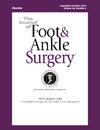抑郁是糖尿病足下肢截肢的预后因素:关于伤口愈合、感染和早期死亡率的前瞻性研究的启示。
IF 1.3
4区 医学
Q2 Medicine
引用次数: 0
摘要
目的:本研究探讨了因糖尿病足而接受下肢截肢手术的糖尿病患者所面临的挑战,尤其侧重于对伤口愈合和早期死亡率的影响。截肢残端伤口可能需要多种手术干预。研究旨在确定与这些结果相关的预后因素,揭示围绕截肢后阶段的复杂性:方法:对 2021 年至 2022 年期间因糖尿病足而接受下肢截肢手术的 39 名糖尿病患者进行了前瞻性研究。详细记录了包括血细胞计数、红细胞沉降率、C 反应蛋白、降钙素原、血红蛋白 A1c、白蛋白、蛋白质、转铁蛋白、铁蛋白水平、年龄、性别、体重指数、吸烟习惯、透析、血管重建、手术时间和手术中止血带使用情况等参数在内的全面术前数据。此外,术前还分别使用迷你精神状态检查(MMSE)和贝克抑郁量表(BDI)评估了患者的认知能力和抑郁状况。通过术后 3 个月的随访,对截肢残端发生感染的患者与未发生感染的患者进行了比较,并对存活患者与死亡患者进行了区分:研究显示,手术中使用止血带会显著增加感染风险(P=0.027),BDI评分越高,感染(AUC=0.814)和死亡(AUC=0.769)的风险越高,24.0和23.5的临界值分别能预测出这些结果,且具有较高的灵敏度和特异性。此外,MMSE评分越低,术后短期死亡率越高。在全血细胞计数、血沉、CRP、降钙素原、HbA1c、白蛋白、总蛋白、转铁蛋白、铁蛋白水平、年龄、性别、体重指数、吸烟、透析、血管重建和手术持续时间等参数方面,组间差异无统计学意义:这项调查强调了考虑糖尿病足截肢患者在截肢期间使用止血带、术前抑郁状态和认知功能的重要性。手术中使用止血带是感染的重要风险因素,而 BDI 评分升高则是截肢患者感染和死亡的有力预测因素。研究结果强调了术前进行多学科神经精神评估对加强患者护理和提高治疗效果的重要性:2级(前瞻性队列研究)。本文章由计算机程序翻译,如有差异,请以英文原文为准。
Depression as a Prognostic Factor in Lower Extremity Amputation for Diabetic Foot: Insights From a Prospective Study on Wound Healing, Infections, and Early Mortality
This study addresses the challenges faced by diabetic patients undergoing lower extremity amputation due to diabetic foot, particularly focusing on the implications for wound healing and early mortality. The wounds at the amputation stump may necessitate multiple surgical interventions. The aim is to identify prognostic factors associated with these outcomes, shedding light on the complexities surrounding the postamputation phase. A prospective study was conducted on 39 diabetic patients who underwent lower extremity amputation due to diabetic foot between 2021 and 2022. Comprehensive preoperative data, encompassing parameters such as blood count, erythrocyte sedimentation rate, C-reactive protein, procalcitonin, hemoglobin A1c, albumin, protein, transferrin, ferritin levels, age, gender, body mass index, smoking habits, dialysis, revascularization, duration of surgery, and the use of tourniquet during the procedure were meticulously recorded. Additionally, cognitive performance and depression status were assessed preoperatively using the Mini-Mental State Examination (MMSE) and Beck Depression Inventory (BDI), respectively. A follow-up period of 3 months postsurgery allowed for the comparison of patients who developed infections at the amputation stump with those who did not, as well as the distinction between patients who survived and those who succumbed to mortality. The study revealed that the use of a tourniquet during surgery significantly increased the risk of infection (p = .027), and higher BDI scores were associated with increased risks of both infection (AUC = 0.814) and mortality (AUC = 0.769), with cut-off scores of 24.0 and 23.5 predicting these outcomes with high sensitivity and specificity, respectively. Additionally, lower MMSE scores were associated with increased short-term postoperative mortality. There were no statistically significant differences between the groups in parameters such as complete blood count, ESR, CRP, procalcitonin, HbA1c, albumin, total protein, transferrin, ferritin levels, age, gender, BMI, smoking, dialysis, revascularization, and surgery duration. This investigation highlights the significance of considering tourniquet usage during amputation, preoperative depression status, and cognitive function in patients who undergo amputation due to diabetic foot. The use of a tourniquet during surgery is a significant risk factor for infection, and elevated BDI scores are strong predictors of both infection and mortality in patients undergoing amputations. The findings underscore the importance of a multidisciplinary neuropsychiatric evaluation preoperatively to enhance patient care and outcomes.
求助全文
通过发布文献求助,成功后即可免费获取论文全文。
去求助
来源期刊

Journal of Foot & Ankle Surgery
ORTHOPEDICS-SURGERY
CiteScore
2.30
自引率
7.70%
发文量
234
审稿时长
29.8 weeks
期刊介绍:
The Journal of Foot & Ankle Surgery is the leading source for original, clinically-focused articles on the surgical and medical management of the foot and ankle. Each bi-monthly, peer-reviewed issue addresses relevant topics to the profession, such as: adult reconstruction of the forefoot; adult reconstruction of the hindfoot and ankle; diabetes; medicine/rheumatology; pediatrics; research; sports medicine; trauma; and tumors.
 求助内容:
求助内容: 应助结果提醒方式:
应助结果提醒方式:


